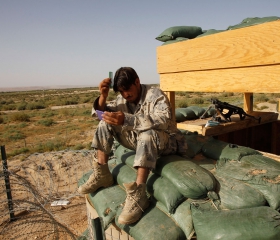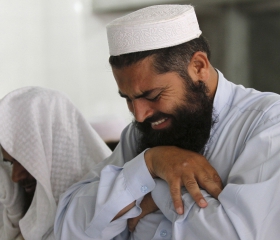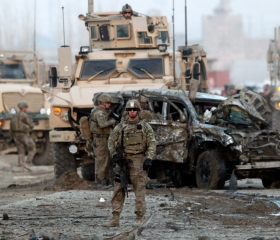In 2015, a number of NATO members decided to continue their military involvement in Afghan affairs. Two agreements on cooperation in the field of security and defense, signed on September 30, 2014 between Afghanistan, on the one hand and the US and NATO, on the other, constituted the legal basis for these operations. Both agreements entered into force on January 1, 2015. Furthermore, on December 12, 2014, the UN Security Council unanimously adopted Resolution 2189 on Afghanistan, according to which NATO's new Resolute Support Mission received a mandate for one year with a possibility of extension.
Resolute Support
On May 13, 2015, NATO Secretary General Jens Stoltenberg said at the meeting of Foreign Ministers of NATO and partner countries contributing to the NATO-led Resolute Support Mission (RSM) in Antalya, Turkey: “We agreed that we will maintain a presence in Afghanistan, even after the end of our current mission, Resolute Support.”
At their next meeting, which took place on December 1, 2015 in Brussels, Belgium, NATO Foreign Ministers adopted a Statement “Resolute Support Nations and Afghanistan,” which says: “Today, NATO Allies and Resolute Support operational partners have agreed to sustain the Resolute Support presence, including in the regions of Afghanistan, during 2016. The mission, including its detailed configuration, will continue to be kept under review and, if necessary, will be adjusted to ensure its effectiveness.”
According to J. Stoltenberg, the number of forces that will remain in Afghanistan as part of the Resolute Support Mission in 2016 will be approximately 12 thousand troops.
These figures differ insignificantly from the current level of foreign military presence in Afghanistan. According to NATO data, as of October 2015, troop numbers and contributions amounted to 13.1 thousand servicemen from 40 countries, of which 1.8 thousand (13%) are from countries that are not members of the Alliance.
Source: Afganistan Resolute Support. Troop Numbers and Contributions
Military presence
The United States makes the largest contribution to this mission, namely 6.8 thousand troops. This is the largest part of American soldiers in Afghanistan. Another three thousand US troops are deployed in Afghanistan as part of Operation Freedom's Sentinel, which followed Operation Enduring Freedom over the many years before it expired in early 2015. In accordance with the US-Afghan agreement of September 30, 2014, the United States has a lease of ten years for military purposes for facilities in Kabul, Bagram, Mazar-i-Sharif, Herat, Kandahar, Helmand, Gardez, Jalalabad and Shindane. But the deployment of neither US, nor other foreign troops in Afghanistan is confined to only these facilities. As of February 2015, all foreign troops involved in the Resolute Support Mission are stationed at 21 bases throughout Afghanistan.
On October 15 of this year, US President Barack Obama announced his decision to maintain the current posture of 9,800 troops in Afghanistan for most of 2016 and decrease it to 5.5 thousand in late 2016 or early 2017. The reduced US troops will be stationed at bases in Bagram, Jalalabad, Kandahar and in the embassy complex in Kabul.
Washington abandoned the plan voiced by the President on May 27, 2014, to reduce the American presence by roughly half and consolidate the troops on Bagram Airfield and in the embassy complex in Kabul, and by the end of 2016 to draw down the military presence in Afghanistan to a “normal embassy presence in Kabul,” which amounts to a battalion.
Most NATO-led Resolute Support Mission partners have expressed solidarity with the United States and a readiness to maintain their military contingents in Afghanistan at current levels in 2016. On November 18, 2015, Germany announced that for the next year it even raised the ceiling on its troops from 850 to 980, but this decision must be approved by the German Bundestag in the beginning of 2016. Most foreign servicemen in Afghanistan as part of the Resolute Support Mission perform non-combat tasks, namely training, advising and assisting Afghan security forces.
However, some countries continue to participate in military operations in Afghanistan. One of the two tasks that the US military and their partner countries perform in Afghanistan is the fight against terrorism (the second task is rendering support to the country’s Armed Forces and law enforcement agencies). The US resolves the first task mainly in the framework of Operation Freedom's Sentinel, while the second – within the Resolute Support Mission.
According to General John Campbell, Commander of US and Coalition Forces in Afghanistan, in October 2015, about 1.3 thousand American servicemen stationed both in Kabul (800 servicemen) and outside it (about 500 servicemen) were involved in the counter-terrorism efforts. 39 percent of 1.3 troops are involved in day-to-day anti-terrorist activities across the country, while the remaining 61 percent are assisting the Afghan security forces.
The figures revealed by John Campbell do not include employees of the Central Intelligence Agency; the fight against terrorism in Afghanistan has figured prominently as one of the Agency’s priorities. Several years ago, the maximum number of CIA representatives in Afghanistan exceeded one thousand people, but after Osama bin Laden's elimination on May 2, 2011, the level of the CIA presence began to decline.
Due to plans announced in 2014 by Barack Obama to confine the presence of US troops in Afghanistan to Bagram Airfield and the embassy complex in Kabul by the end of 2015, as well as under the influence of a terrorist attack on a diplomatic mission and a CIA annex in Benghazi (Libya) in September 2012, the agency informed in 2014 that CIA case officers and analysts as well as National Security Agency specialists would be pulled back to Kabul, and that operations outside the Afghan capital would be shuttered substantially.
Perhaps, the 2015 decision to maintain the number of US troops in Afghanistan at the level of 9.8 thousand was taken under the influence of the US intelligence community, which, according to some authors, feared for the safety of its installations in that country, should this level be lowered. For their part, the US military feared that curtailing the activities of intelligence officers outside Kabul would have a negative impact on the provision of intelligence and operational data.
The figures revealed by J. Campbell do not take into account contractors of the US Department of Defense either. According to the data provided in October 2015 by the Office of Assistant Secretary of Defense Alan F. Estevez, 30.2 thousand people work under contract for the US Department of Defense in Afghanistan. Of these, only 10.3 thousand are US citizens. Other contractor personnel are citizens of Afghanistan (12.9 thousand) and of third countries (6.9 thousand).
In terms of mission categories, the majority of contractor personnel work in logistics and maintenance. However, according to available data, 1.7 thousand people are engaged in security (5.5 percent of the total contract personnel) and 1.0 thousand people in training (3.4 percent). The work of contract personnel is exposed to the gravest dangers. This is evidenced by the fact that between 2001 and 2015 in Afghanistan 2.2 thousand US troops were killed while at least 1.6 thousand contract personnel working for the US Department of Defense lost their lives.
The NATO-led Resolute Support Mission members can also take part in the fighting in Afghanistan. This mostly refers to the efforts of combating terrorism. The Special Operations Joint Task Force-Afghanistan (SOJTF-A), established in 2012 to combine the efforts of special services of Afghanistan and of the Allied nations as well as of their Resolute Support partners, plays the leading role in these efforts by NATO and their allies. In 2013, the SOJTF-A strength was 13 thousand servicemen, representing more than 20 countries. In late 2014, the number of this group was reduced to a battalion.
Leaving or staying?
There are three reasons for extending the military presence of the United States and its allies in Afghanistan.
First, as Barack Obama said, “in key areas of Afghanistan, the security situation is still very fragile and in some places there is risk of deterioration.” In addition to the risks associated with the terrorist organizations of al-Qaeda and the Taliban, there are new ones. According to US military, the so-called Islamic State is now trying to gain a foothold in Afghanistan. Its activity has been detected in 25 of 34 provinces. The number of active supporters of this terrorist institution in Afghanistan may amount to three thousand people.
Second, the extension of the foreign military presence may be associated with the state of the Armed Forces and law enforcement agencies of Afghanistan. According to Barack Obama, “Afghan forces are not as strong as they need to be.” After the attack of the Taliban on Kunduz in northern Afghanistan at the end of September, General John Campbell noted that the armed forces of Afghanistan do very well when they plan and preplan, but in a crisis mode they continue to need [outside] help.
Third, maintaining, above all, US troops in Afghanistan can pursue strategic goals. When testifying before the House Armed Services Committee on US strategy in Afghanistan John Campbell defined this goal, emphasizing that the presence was tantamount to influence. “If you have people on the ground, you have influence. And if you won’t provide influence, somebody else would be there, whether it be Russia, China or Iran.”
The prospects for foreign military presence in Afghanistan vary at multilateral and bilateral levels. NATO-led Resolute Support Mission can be transformed in 2016 into Enduring Partnership Mission, but the number and nature of the latter is unlikely to be very different from Resolute Support. This is evidenced by the above statements of J. Stoltenberg and the mentioned decisions of the Mission’s members to maintain military contingents in Afghanistan. However, the future of NATO's mission after 2016 remains uncertain.
As for the bilateral level, the prospects for the foreign military presence in Afghanistan will largely depend, first, on the state of US-Afghan relations and, second, on Washington's policy in the field of security before and after the US presidential election.
As of today, the political dialogue between Washington and Kabul suggests that in the coming years the US will be able to have military installations and to conduct special operations in Afghanistan.
The peculiar features of Washington's policy in the field of security today are as follows.
First, the policy of Washington is characterized by a shifting emphasis in the use of the armed forces to the conflict zones, which by all means include Afghanistan. The main role is to be played by air strikes, in which special importance is attached to unmanned aerial vehicles (in 2015, with the help of drones 175 air strikes were launched, killing about a thousand people, and special operations).
Although currently more than 90 percent of special operations in Afghanistan are conducted by national forces, American and other groups of special forces will continue to play a variety of roles in Afghanistan from training, advising and assisting Afghan special forces to direct participation in them.
An increased use of US Special Forces has become a characteristic feature of Barack Obama’s presidency. If in 2010 Special Operation forces were deployed in 75 countries around the world, in 2014 that figure swelled to 133 countries.
Second, the US seeks to reduce the burden on its own armed forces by creating coalitions and delegating responsibility for security to national law enforcement agencies, as well as by involving contract personnel in performing tasks in the framework of military missions and operations.







